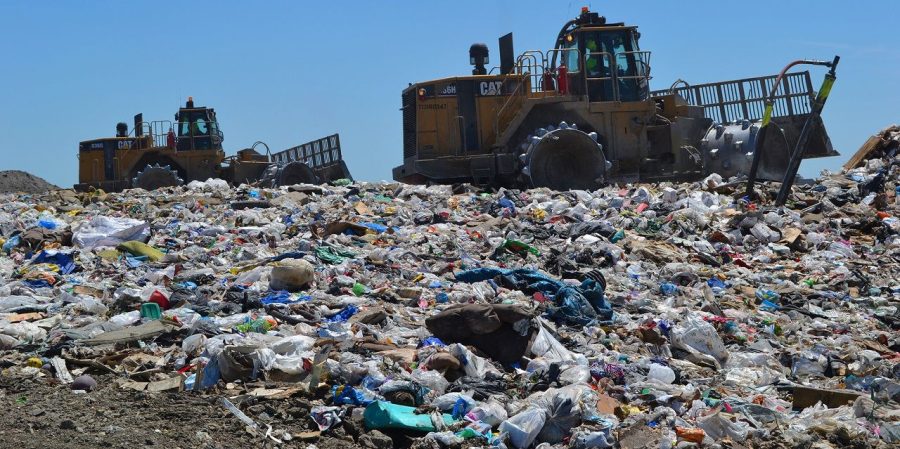Why People Should Switch from Using Single-Use Water Bottles to Reusable Water Bottles
Courtesy of Pennsylvania Record
Photograph of Bethlehem Landfill in Northampton County
April 29, 2020
One million single-use plastic water bottles are purchased around the world every minute. In the United States, 1,000 people open a bottle of water every second. The majority of this plastic waste has ended up in landfills and the environment, which has caused human health problems and has forced a multitude of animal species to face possible extinction.
Single-use water bottles have negatively impacted the world for many years, and they can be found virtually anywhere. Whether it is at a sporting event, concert, an airport or even a trip to Holy Grounds at the University, these water bottles are always available for purchase.
While single-use water bottles can be a convenient solution to stay hydrated on a hot day, it is essential for people to understand the harm that they are capable of causing in the world. According to UN Environment, just nine percent of all plastic waste has ever been recycled and 12% has been incinerated. The other 79% has ended up in landfills and the environment.
While single-use water bottles have become a normal part of some people’s lives, the poor disposal of them have led to health problems for humans. UN Environment also stated that since plastics have long-lasting durability and strong resistance to degradation, it becomes extremely difficult for nature to break them down.
It can take up to 1,000 years for a single water bottle to decompose. In fact, most plastics never fully vanish, but rather decrease in size and become tiny particles that are consumed by farm animals and fish that mistake them for food. Considering this, humans that eat these farm animals and fish can also eat the tiny plastic particles. The Guardian reported that humans consume about 100 bits of microplastic over the course of just one meal, and the average person consumes 70,000 microplastics annually.
In addition to the harmful effect single-use plastics have on humans, they are also highly detrimental to wildlife. According to Global Citizen, single-use water bottles contribute to the killing of more than one million animals and seabirds every year. As a result, nearly 700 species of marine life are facing extinction due to the increase of plastic pollution.
UN Environment stated that if current trends continue, oceans could potentially contain more plastic than fish by 2050. Despite their negative impact, people continue to buy single-use water bottles, and there is no sign of slowing down. In the U.S., people open a bottle of water every second, per Healthy Human, and the consumption of bottled water increases by 10% each year.
Americans also throw away approximately 60 million water bottles, daily which mostly end up in landfills or on the country’s streets, parks and waterways. U.S. landfills are overflowing with more than two million tons of discarded water bottles, and studies show that the decomposing bottles release toxins into the environment that can cause reproductive problems and cancer.
To add to the disturbing list of facts, citizens in the U.S. throw away 35 billion empty water bottles annually. Of those, just 12% are recycled. Even of the bottles that are put in recycling bins in homes, a staggering 50% of them are never recycled.
Given the damaging effect of single-use water bottles, an effective solution is to use reusable water bottles. Reusable water bottles reduce a person’s carbon footprint. They also help reduce the plastic burden on landfills, oceans, rivers and other locations where they could potentially end up. Most health organizations recommend stainless steel water bottles. They take less oil to produce, and it is almost impossible for it to contribute to plastic waste. Stainless steel water bottles also guarantee no risk of toxins leaking into beverages.
While reusable water bottles have many benefits of their own, the most important factor of using them is that they decrease the use of single-use water bottles. By deciding to go with an alternative option to single-use bottles, one can reduce the constant strain on the environment.
While single-use water bottles are sometimes a convenient option for people, they are extremely harmful to the environment and are detrimental to wildlife as well as humans. Using reusable water bottles instead mitigates the damage that is done and prevents these horrible outcomes.
It is crucial for people to spread awareness about the issue to increase general understanding in society. While an individual who makes this switch may not seem like a significant action, it sets a great example for others to follow. One by one, if people can change the way they stay hydrated and continue to pass this message along, the small contributions will add up and work towards the elimination of this massive environmental issue.


